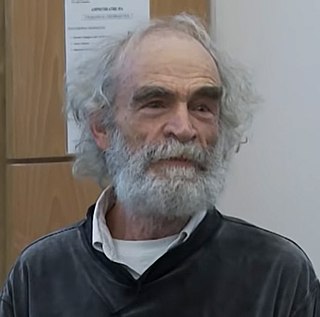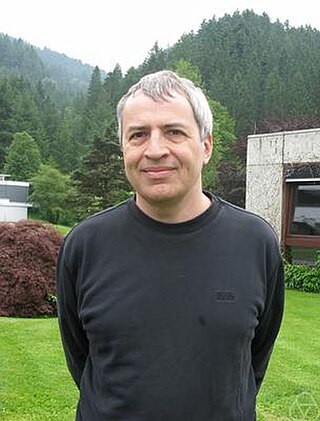Related Research Articles
Riemannian geometry is the branch of differential geometry that studies Riemannian manifolds, defined as smooth manifolds with a Riemannian metric. This gives, in particular, local notions of angle, length of curves, surface area and volume. From those, some other global quantities can be derived by integrating local contributions.
In the mathematical field of Riemannian geometry, the scalar curvature is a measure of the curvature of a Riemannian manifold. To each point on a Riemannian manifold, it assigns a single real number determined by the geometry of the metric near that point. It is defined by a complicated explicit formula in terms of partial derivatives of the metric components, although it is also characterized by the volume of infinitesimally small geodesic balls. In the context of the differential geometry of surfaces, the scalar curvature is twice the Gaussian curvature, and completely characterizes the curvature of a surface. In higher dimensions, however, the scalar curvature only represents one particular part of the Riemann curvature tensor.

Shing-Tung Yau is a Chinese-American mathematician. He is the director of the Yau Mathematical Sciences Center at Tsinghua University and professor emeritus at Harvard University. Until 2022, Yau was the William Caspar Graustein Professor of Mathematics at Harvard, at which point he moved to Tsinghua.
In mathematics, Gromov–Hausdorff convergence, named after Mikhail Gromov and Felix Hausdorff, is a notion for convergence of metric spaces which is a generalization of Hausdorff distance.
This is a glossary of some terms used in Riemannian geometry and metric geometry — it doesn't cover the terminology of differential topology.

Eugenio Calabi was an Italian-born American mathematician and the Thomas A. Scott Professor of Mathematics at the University of Pennsylvania, specializing in differential geometry, partial differential equations and their applications.
In the mathematical field of differential geometry, Ricci-flatness is a condition on the curvature of a Riemannian manifold. Ricci-flat manifolds are a special kind of Einstein manifold. In theoretical physics, Ricci-flat Lorentzian manifolds are of fundamental interest, as they are the solutions of Einstein's field equations in a vacuum with vanishing cosmological constant.
Hopf–Rinow theorem is a set of statements about the geodesic completeness of Riemannian manifolds. It is named after Heinz Hopf and his student Willi Rinow, who published it in 1931. Stefan Cohn-Vossen extended part of the Hopf–Rinow theorem to the context of certain types of metric spaces.

Richard Streit Hamilton was an American mathematician who served as the Davies Professor of Mathematics at Columbia University.

Mikhael Leonidovich Gromov is a Russian-French mathematician known for his work in geometry, analysis and group theory. He is a permanent member of Institut des Hautes Études Scientifiques in France and a professor of mathematics at New York University.
In the mathematical field of differential geometry, there are various splitting theorems on when a pseudo-Riemannian manifold can be given as a metric product. The best-known is the Cheeger–Gromoll splitting theorem for Riemannian manifolds, although there has also been research into splitting of Lorentzian manifolds.
In mathematics, the soul theorem is a theorem of Riemannian geometry that largely reduces the study of complete manifolds of non-negative sectional curvature to that of the compact case. Jeff Cheeger and Detlef Gromoll proved the theorem in 1972 by generalizing a 1969 result of Gromoll and Wolfgang Meyer. The related soul conjecture, formulated by Cheeger and Gromoll at that time, was proved twenty years later by Grigori Perelman.

Richard Melvin Schoen is an American mathematician known for his work in differential geometry and geometric analysis. He is best known for the resolution of the Yamabe problem in 1984 and his works on harmonic maps.

Thierry Aubin was a French mathematician who worked at the Centre de Mathématiques de Jussieu, and was a leading expert on Riemannian geometry and non-linear partial differential equations. His fundamental contributions to the theory of the Yamabe equation led, in conjunction with results of Trudinger and Schoen, to a proof of the Yamabe Conjecture: every compact Riemannian manifold can be conformally rescaled to produce a manifold of constant scalar curvature. Along with Yau, he also showed that Kähler manifolds with negative first Chern classes always admit Kähler–Einstein metrics, a result closely related to the Calabi conjecture. The latter result, established by Yau, provides the largest class of known examples of compact Einstein manifolds. Aubin was the first mathematician to propose the Cartan–Hadamard conjecture.
In the mathematical field of Riemannian geometry, the Berger spheres form a special class of examples of Riemannian manifolds diffeomorphic to the 3-sphere. They are named for Marcel Berger who introduced them in 1962.
In mathematics, the Cartan–Hadamard theorem is a statement in Riemannian geometry concerning the structure of complete Riemannian manifolds of non-positive sectional curvature. The theorem states that the universal cover of such a manifold is diffeomorphic to a Euclidean space via the exponential map at any point. It was first proved by Hans Carl Friedrich von Mangoldt for surfaces in 1881, and independently by Jacques Hadamard in 1898. Élie Cartan generalized the theorem to Riemannian manifolds in 1928. The theorem was further generalized to a wide class of metric spaces by Mikhail Gromov in 1987; detailed proofs were published by Ballmann (1990) for metric spaces of non-positive curvature and by Alexander & Bishop (1990) for general locally convex metric spaces.
In geometry, Alexandrov spaces with curvature ≥ k form a generalization of Riemannian manifolds with sectional curvature ≥ k, where k is some real number. By definition, these spaces are locally compact complete length spaces where the lower curvature bound is defined via comparison of geodesic triangles in the space to geodesic triangles in standard constant-curvature Riemannian surfaces.

John William Lott is a professor of Mathematics at the University of California, Berkeley. He is known for contributions to differential geometry.
In Riemannian geometry, a field of mathematics, Preissmann's theorem is a statement that restricts the possible topology of a negatively curved compact Riemannian manifold. It is named for Alexandre Preissmann, who published a proof in 1943.
In mathematics, the intrinsic flat distance is a notion for distance between two Riemannian manifolds which is a generalization of Federer and Fleming's flat distance between submanifolds and integral currents lying in Euclidean space.
References
- ↑ Bridson & Haefliger 1999, Theorem 5.41; Burago, Burago & Ivanov 2001, Theorem 7.4.15; Gromov 1981, Section 6; Gromov 1999, Proposition 5.2; Petersen 2016, Proposition 11.1.10.
- ↑ Villani 2009, p. 754.
- ↑ Gromov 1981, Section 7; Gromov 1999, Paragraph 5.7.
- ↑ Bridson & Haefliger 1999, Definition 5.50; Gromov 1993, Section 2.
- ↑ Gromov 1999, Theorem 5.3; Petersen 2016, Corollary 11.1.13.
- ↑ Gromov 1999, Paragraph 5.5.
Sources.
- Bridson, Martin R.; Haefliger, André (1999). Metric spaces of non-positive curvature. Grundlehren der mathematischen Wissenschaften. Vol. 319. Berlin: Springer-Verlag. doi:10.1007/978-3-662-12494-9. ISBN 3-540-64324-9. MR 1744486. Zbl 0988.53001.
- Burago, Dmitri; Burago, Yuri; Ivanov, Sergei (2001). A course in metric geometry. Graduate Studies in Mathematics. Vol. 33. Providence, RI: American Mathematical Society. doi:10.1090/gsm/033. ISBN 0-8218-2129-6. MR 1835418. Zbl 0981.51016. (Erratum: )
- Gromov, Mikhael (1981). "Groups of polynomial growth and expanding maps". Publications Mathématiques de l'Institut des Hautes Études Scientifiques . 53: 53–73. doi:10.1007/BF02698687. MR 0623534. S2CID 121512559. Zbl 0474.20018.
- Gromov, M. (1993). "Asymptotic invariants of infinite groups". In Niblo, Graham A.; Roller, Martin A. (eds.). Geometric group theory. Vol. 2. Symposium held at Sussex University (Sussex, July 1991). London Mathematical Society Lecture Note Series. Cambridge: Cambridge University Press. pp. 1–295. ISBN 0-521-44680-5. MR 1253544. Zbl 0841.20039.
- Gromov, Misha (1999). Metric structures for Riemannian and non-Riemannian spaces. Progress in Mathematics. Vol. 152. Translated by Bates, Sean Michael. With appendices by M. Katz, P. Pansu, and S. Semmes. (Based on the 1981 French original ed.). Boston, MA: Birkhäuser Boston, Inc. doi:10.1007/978-0-8176-4583-0. ISBN 0-8176-3898-9. MR 1699320. Zbl 0953.53002.
- Petersen, Peter (2016). Riemannian geometry. Graduate Texts in Mathematics. Vol. 171 (Third edition of 1998 original ed.). Springer, Cham. doi:10.1007/978-3-319-26654-1. ISBN 978-3-319-26652-7. MR 3469435. Zbl 1417.53001.
- Villani, Cédric (2009). Optimal transport. Old and new. Grundlehren der mathematischen Wissenschaften. Vol. 338. Berlin: Springer-Verlag. doi:10.1007/978-3-540-71050-9. ISBN 978-3-540-71049-3. MR 2459454. Zbl 1156.53003.